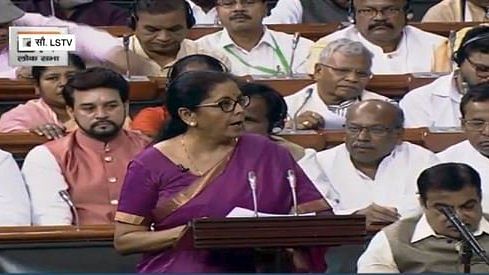Why I give Budget a ‘B’
Bhaskar Chakarborty | Dean of Global Business at The Fletcher School at Tufts University
The Indian Express
The author, highlights the three misses and three hits of this budget. Overall though, he is not impressed with it. The three misses, he notes, are as follows: first, the budget failed to provide a “comprehensive plan across a wider range of job-creating manufacturing opportunities”. Second, there was little in the budget about strengthening India’s capabilities in the digital sector — it has a long distance to go before it can become globally competitive in the ease of doing digital business. And third, the budget didn’t adequately address concerns related to climate change.
On the positive side, however, the author adds, the proposals to boost FDI in certain sectors are welcome. The continued push on infrastructure development is also welcome. And third, he praises the intention to provide every rural family with electricity and cooking gas by 2022.
No direct measure, but can feel-good spur private investment?
C Rangarajan | Former governor, RBI
The Economic Times
The budget, presented amid an economic slowdown, inadequate private investment, agrarian distress and financial sector problems, has provided a host of measures to address these but much of it will depend on implementation. Fiscal deficit target pegged at 3.3 per cent indicates the government’s commitment to fiscal consolidation. Non-tax revenues will be critical. The government should be willing to adjust expenditures if the revenue growth is below the desired rate. Tax concessions on affordable houses and on purchase of electrical vehicles are welcome moves, though the government must rethink the imposition of customs duties on certain products as this is a reversal of liberalisation trends and creates controversies globally. However, the critical point is that though the Economic Survey and budget talked of private investment driven growth there is no concrete measure announced which will spur private investment.
We can strike the GDP target, provided economy does well, rupee appreciates
Bibek Debroy | Chairman, Economic Advisory Council-Prime Minister
Mint
A target to achieve $5 trillion economy by 2024 has a nice, round aspirational ring to it, writes Debroy. This target and back calculation involves exchange rates. For instance, if the rupee depreciates annually by 2 per cent, growth will have to be around 13.5 per cent. Exports can’t be a major growth driver despite reforms due to external conditions. Several reforms undertaken between 2014 and 2019 have been on the supply-side, which will yield productivity and growth dividends a couple of years down the line. “Therefore, we are probably going to witness a gradual inching up of growth to 8 per cent and even 8.5 per cent,’ he says, adding that it is neither likely to remain at 7.5 per cent nor touch 9.5 per cent. The mid-point of 8.5% is the most likely scenario.
Searching for reform signals
M Govinda Rao | Member, Fourteenth Finance Commission, and former Director, NIPFP
The Hindu
Mr Rao suggests that one of the most important reform measures in the budget “is the proposal to streamline multiple labour laws into a set of four labour codes”. As of now, however, not much details are available about it.
He says that some of the measures “take us back to the pre-reform era”. By selective increases in customs duty, the budget “can create unintended distortions”. He writes that even though the budget allocates money for the recapitalisation of banks, it doesn’t address the structural reforms required for the banking sector. It also doesn’t provide any substantial measures to deal with the NBFC crisis, adds the author.
He argues that contrary to the Economic Survey’s suggestion of transforming “dwarfs into giants” with regards to MSMEs, the budget actually reiterates the idea that “small is beautiful”.
Union Budget: A lost opportunity
Yamini Aiyar | President and chief executive, Centre for Policy Research
Hindustan Times
In this piece, Yamini Aiyar, argues that this budget is an “opportunity lost”. Instead of adopting bold and structural reforms, the budget takes an incremental route.
While the government’s decision to resist any new major announcement for welfare spending is welcome, she argues, the government also simultaneously failed to articulate a vision for the rural economy, particularly agriculture. She suggests that the solutions offered in the budget like increased agricultural investments or setting-up of farmer producer organisations are just “piecemeal”. Well-known issues facing agriculture like a regressive subsidy regime, badly regulated markets or weak procurement infrastructure have been overlooked, she adds.
She adds that even though the details of budgetary allocation are usually not required in the FM’s speech, on this instance, they should have been provided to restore the credibility of the government’s fiscal maths.
A silent fiscal crisis?
Rathin Roy | Director, National Institute of Public Finance and Policy
Business Standard
Roy writes that this was the first budget with no paragraphs on the fiscal situation which along with tax proposals forms the core– and the reason might be constrained fiscal space. “It is understandable: It has not been the tradition in India to confront such difficulties openly,” he says.
While the budget documents suggest business as usual, the Economic Survey based on the Comptroller General of India accounts presents a different and worrying picture. If CGA—the authorised institution to issue fiscal accounts—is way off mark then there could be a collapse of credibility of fiscal accounts. The proposal that the government borrow more from foreigners to finance expenditure is worrying on grounds of economic security, though there is no detail prescription on this. Transparency and consultation are key before taking this step.






